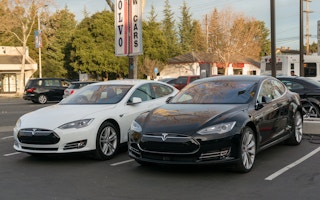The recent oil pipeline spill in Santa Barbara has been an unfortunate case of déjà vu, bringing back collective memories of oil-slicked seabirds and blackened beaches. It came not long after President Obama approved oil exploration in the Arctic. These offer stark reminders that America’s addiction to oil is alive and well.
For all our progress on clean energy, our cars and trucks remain reliant on petroleum, which still provides a full 92 per cent of energy for transportation in the U.S. Environmentalists argue that we can and must transition the transportation sector off of it, since burning petroleum for transportation is responsible for a quarter of our greenhouse gas emissions. The most promising pathways proposed are electric vehicles and hydrogen fuel cells, which would allow us to travel using electricity instead of gasoline as our energy source. Teslas and Nissan Leafs are already cruising highways, proving that electric vehicles are no longer just a pipe dream, but quickly becoming a concrete reality.
What if we switched out all of our gas-guzzlers for electricity guzzlers? A future of fully electrified transportation would boost electricity demand in a dramatic way. In fact, a full-scale conversion to electric transportation would require around a 35 per cent increase in electricity demand. That would constitute a major change for the U.S. electricity market, where demand has been almost flat in recent years.
This idea may initially make environmentalists’ hearts sink, since reducing electricity demand has long been a cornerstone of proposals to fight climate change. However, if history is any guide, a big increase in electricity demand may be just what we need to boost clean energy.
“
This idea may initially make environmentalists’ hearts sink, since reducing electricity demand has long been a cornerstone of proposals to fight climate change. However, if history is any guide, a big increase in electricity demand may be just what we need to boost clean energy.
Replacing oil with electricity follows the pattern of past energy transitions in the U.S., which have a long history of moving toward better, cleaner energy technologies. Although it may be an environmental foe now, oil was itself once an environmental savior: the invention of kerosene in the 19th century allowed us to stop hunting whales for their oil, which was a crucial lighting source at the time. Similarly, coal helped spare vast tracts of American forests from the saw, since it meant we no longer needed wood for heating.
Some might fear that an increase in electricity demand would simply be met by fossil fuels. Indeed, in order for electricity to offer emissions benefits over gasoline, it would have to come from clean energy sources. But government regulations have already made coal much more expensive, and thanks to the fracking boom, coal is losing out all over the country to cheaper, cleaner natural gas. An increase in electricity demand can help further this process of substituting dirtier fuels with cleaner ones and would create opportunities to improve the economics and streamline regulation of carbon-free sources such as renewables and nuclear.
A transition to cleaner power as demand increases also makes sense if we consider the old adage, “Necessity is the mother of invention.” With electricity demand fairly flat in the U.S., it is hard to encourage innovation in clean technologies: The lights are always on, so barring strong environmental policies, there is no reason to shift away from a fossil-fuel-based system that is doing the job. Increased demand due to a large-scale shift to electrified transportation, however, would make the U.S. market more like that of China or India, where huge unmet electricity demand creates markets more likely to encourage clean energy innovation. These countries are already starting to shift away from coal to reduce local air pollution, and they are embracing policies to invest in a variety of clean energy technologies so they can simultaneously meet electricity demand and grow their economies. An increase in electricity demand in the U.S. could be just what this country needs to galvanize research and development into next-generation solar and wind or safer, more resilient nuclear power plants.
The long American love affair with the internal combustion engine is unlikely to die completely with the electric car. But the electrification of transportation has the potential to be revolutionary for the American energy sector. It would divorce us from our economy’s single largest use of petroleum — and, if we play our cards right, could yield huge environmental benefits by boosting demand for clean electricity. The pelicans of Santa Barbara would thank us.
Marian Swain is a conservation analyst at the Breakthrough Institute in Oakland, California. Iddo Wernick is a senior research associate at the Program for the Human Environment at Rockefeller University. This article is republished from Ensia.











